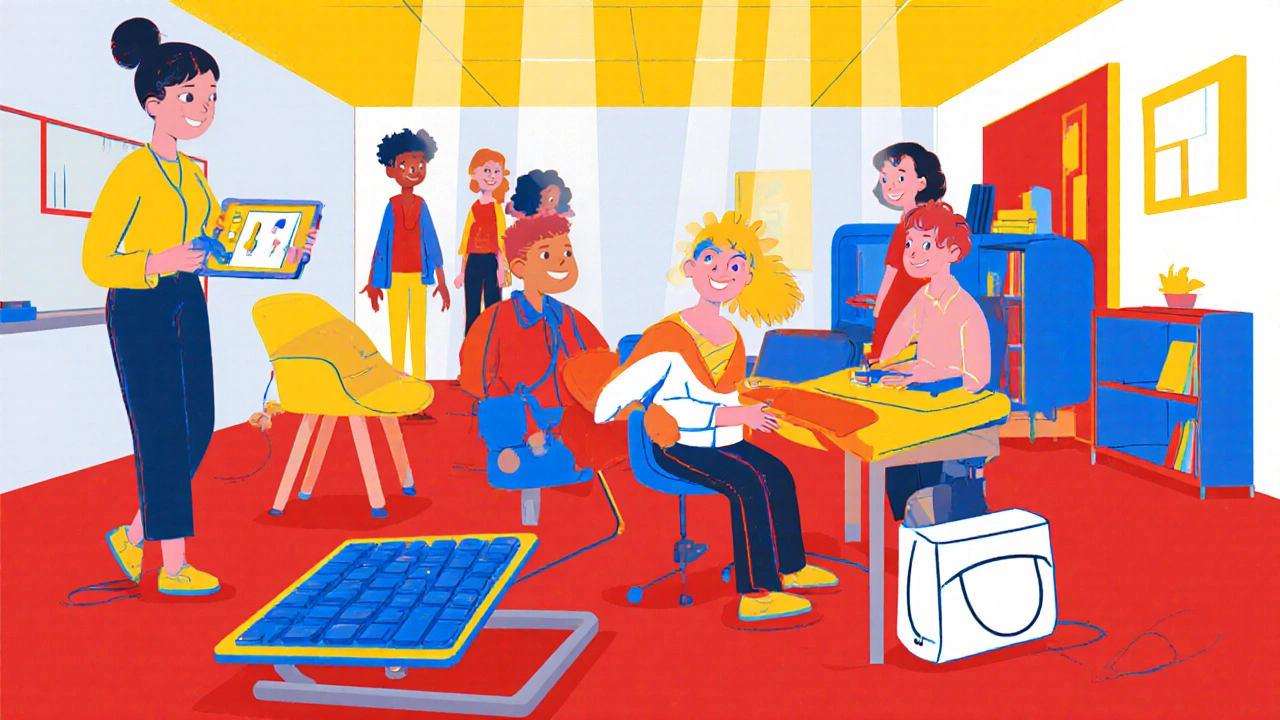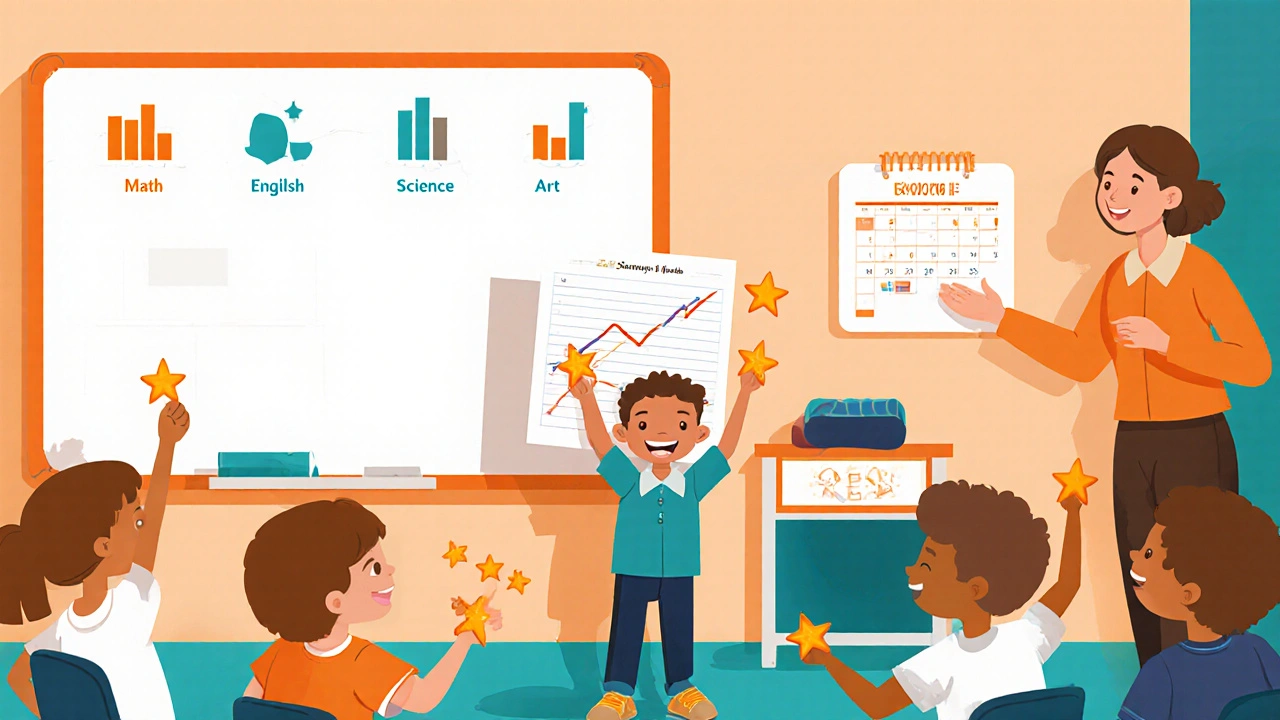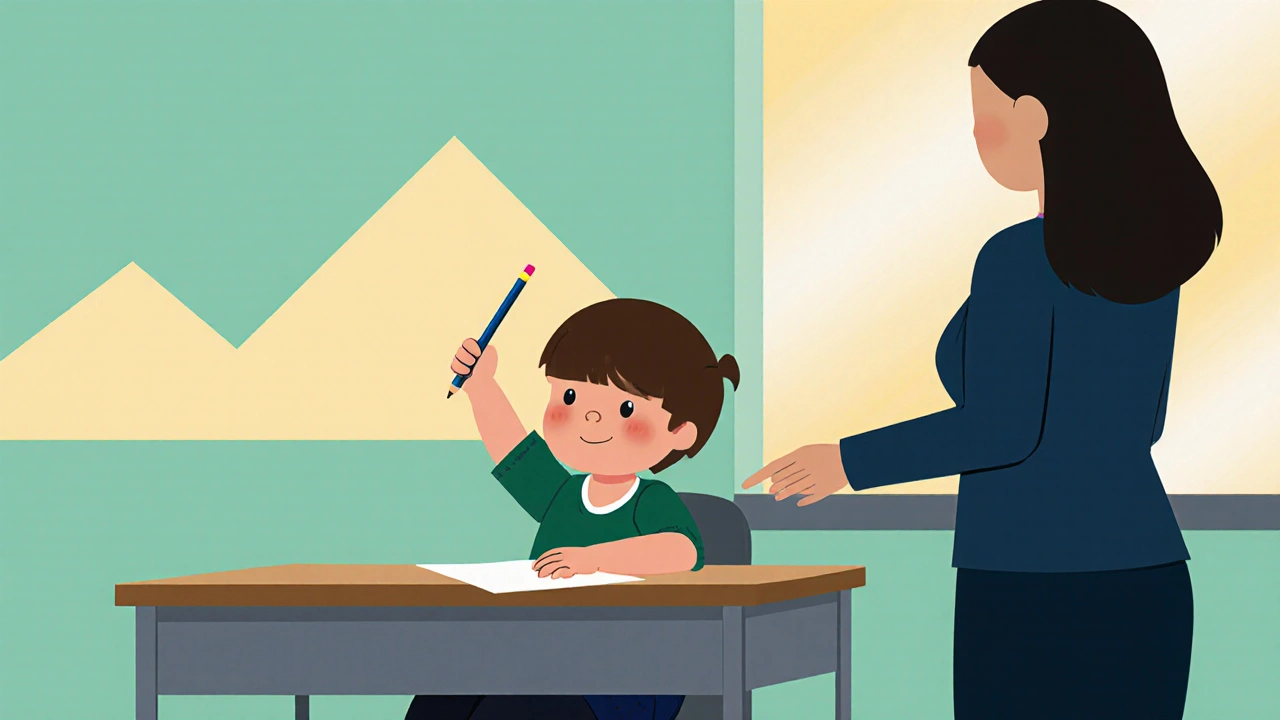Assistive Technology Comparison Tool
Key Takeaways
- Understand how poor muscle control affects learning and daily school tasks.
- Implement low‑cost classroom tweaks that boost independence.
- Partner with therapists and families to create personalized support plans.
- Use assistive technology wisely to reduce fatigue and frustration.
- Monitor progress with clear data and adjust strategies as needed.
When a child struggles with poor muscle control, even simple school activities like writing, cutting, or typing can feel like climbing a mountain. Teachers often wonder how to keep these students engaged without holding them back. The good news? A mix of practical classroom tweaks, targeted therapy, and smart tech can turn the experience around for both the student and the whole class.
Poor Muscle Control is a condition where a student’s fine or gross motor muscles lack the strength, coordination, or timing needed for everyday tasks. It can stem from developmental disorders, cerebral palsy, muscular dystrophy, or simply a delay in motor skill acquisition. The result is fatigue, sloppy handwriting, shaky drawing, or difficulty holding a pen for more than a few minutes. While the medical side matters, the classroom is where learning either stalls or flourishes. Below, we break down a step‑by‑step playbook that teachers, aides, and parents can use to set the student up for success.
1. Diagnose the Impact, Not Just the Diagnosis
Before you can adjust the environment, you need a clear picture of how the muscle issue shows up in class. Start with a quick observation checklist:
- How long can the student write legibly before the hand cramp?
- Does the child avoid activities that require hand‑eye coordination, like cutting or assembling puzzles?
- Are there signs of fatigue during long seated tasks?
- What assistive devices (slant boards, weighted pencils) are already in use?
- Which subjects trigger the most frustration?
Collect data over a week and share it with the school’s occupational therapist (OT). The OT will help translate raw observations into measurable goals-e.g., “Increase sustained writing time from 3 to 6 minutes over six weeks.” Having concrete targets makes it easier to pick the right accommodations.
2. Build an Inclusive Education Framework
Inclusive Education is an approach that designs learning experiences so that every student, regardless of ability, can participate fully. It isn’t a special‑education add‑on; it’s a mindset that reshapes lesson planning, classroom layout, and assessment methods. Here’s how you can embed inclusion without overhauling the entire curriculum:
- Universal Design for Learning (UDL): Offer information in multiple formats-visual, auditory, and kinesthetic. For example, when introducing a new math concept, pair a short video with a hands‑on manipulatives activity.
- Flexible Seating: Provide options such as wobble chairs, stability balls, or standing desks. These help students with poor muscle control find a posture that reduces tremors.
- Chunked Instructions: Break complex directions into bite‑size steps. Write each step on the board and let the student check off completed items.
When the whole class benefits from these tweaks, stigma disappears, and the student with poor muscle control feels less singled out.
3. Leverage Occupational Therapy Insights
OTs are the go‑to experts for fine motor challenges. A typical OT session might include:
- Grip strengthening using therapy putty or hand‑grip trainers.
- Sensory integration activities like brushing or weighted blankets to calm the nervous system.
- Training on tool adaptations (e.g., pencil grips, scissors with spring‑loaded handles).
Ask the OT to provide a short “tool kit” for classroom use. Teachers can then keep a portable OT bag with the necessary aids, ensuring the student has quick access during lessons.
4. Choose Assistive Technology Wisely
Technology can level the playing field, but not every gadget fits every kid. Below is a comparison of common assistive tools that work well in primary and secondary classrooms.
| Device | Primary Benefit | Cost Range (AU$) | Ideal Use Cases |
|---|---|---|---|
| Adaptive Keyboard (large‑key, silicone‑covered) | Reduces finger fatigue, improves typing accuracy | 80‑250 | Writing assignments, digital tests |
| Voice‑to‑Text Software (e.g., Dragon NaturallySpeaking) | Eliminates need for sustained hand pressure | 150‑300 (school license) | Essay writing, note‑taking |
| Slant Board with Non‑Slip Surface | Maintains wrist angle, lessens tremor | 30‑70 | Reading, writing, drawing |
| Switch‑Activated Tablet Stylus | Requires a light press; optional palm rejection | 45‑120 | Digital drawing, labeling diagrams |
| Eye‑Gaze Tracking Device | Controls cursor without hand use | 1,200‑3,000 | Advanced computer tasks, communication |
Before buying, pilot the device in the classroom for a week. Ask the student if it feels easier, and track objective data (e.g., time to complete a writing task). If the tool doesn’t improve speed or accuracy, move on to the next option.

5. Craft an Individualized Education Plan (IEP) That Works
The IEP is the legal document that locks in accommodations. A well‑written IEP for a student with poor muscle control should contain:
- Current Performance: Include observed writing stamina, hand‑eye coordination scores, and therapist notes.
- Measurable Goals: Example - “Increase legible handwriting from 50 % to 80 % accuracy on weekly tests within 12 weeks.”
- Accommodations: List specific tools (adaptive keyboard), modified assignments (extra time, oral response), and environmental tweaks (standing desk).
- Related Services: Frequency of OT, PT, or speech‑language sessions.
- Progress Monitoring: Define how teachers will record data-e.g., weekly checklists, digital logs.
Invite the student’s parents to the planning meeting. When families see the concrete steps, they’re more likely to reinforce the strategies at home.
6. Teach Self‑Advocacy Early
Kids who understand their own needs can request help before frustration builds. Role‑play scenarios in class:
- “If my hand cramps, I can raise my hand and say ‘I need a break, please.’”
- “When I need a larger pencil, I can pull the adaptive pen from my desk drawer.”
Witnessing peers respect these requests creates a culture of empathy. Plus, the school’s documentation of self‑advocacy counts toward the IEP’s progress metrics.
7. Integrate Sensory Breaks Without Disrupting Flow
Short, structured breaks can reset muscle fatigue. Here are five classroom‑friendly ideas:
- Stretch Station: A wall‑mounted strip with visual cues for shoulder rolls, wrist stretches, and finger flexes.
- Weighted Lap Pad: A 2‑kg lap pad can provide proprioceptive input while the student listens to a lecture.
- Ball Roll: Rolling a light therapy ball across the floor for 30 seconds.
- Deep‑Breathing Timer: A sand timer to guide 1‑minute breathing cycles.
- Music‑Cue Transition: Play a 20‑second cue song that signals a quick movement break.
Schedule breaks every 20‑30 minutes for children with severe motor challenges, and let the student choose the activity that feels most restorative.
8. Monitor, Reflect, and Adjust
Data is the compass that tells you whether the plan works. Set up a simple spreadsheet with columns for:
- Date
- Task (e.g., spelling test)
- Assistive tool used
- Time to complete
- Accuracy (%)
- Student’s self‑rating of effort (1‑5)
Review the sheet with the OT and parents every six weeks. If the student’s accuracy improves but fatigue spikes, consider swapping a tool or adding a longer break.

9. Foster Peer Understanding
When classmates know why a friend uses a slant board or an adaptive pen, they’re less likely to treat it as “weird.” A quick class discussion that frames the tools as “helping everyone stay focused” builds inclusion naturally. You can even turn the tools into a classroom “help kit” that any student can borrow, normalizing their presence.
10. Celebrate Small Wins
Every extra minute of writing, every successful cut with scissors, or every time the student asks for a break without prompting is a victory. Publicly acknowledge progress-e.g., “Great job staying focused for 8 minutes on the worksheet, Maya!”-and link it back to the strategy that made it possible. Positive reinforcement encourages the student to keep using the tools and keeps morale high for the whole class.
Putting It All Together: A Sample Week in Action
Below is a snapshot of how a teacher might weave these ideas into a typical week for a Year 5 student named Sam.
- Monday - Math: Sam uses an adaptive keyboard for the timed quiz. The teacher breaks the instructions into three steps and checks Sam off on a visual list.
- Tuesday - English: A slant board is set up for the writing exercise. After 10 minutes, Sam takes a 5‑minute stretch break.
- Wednesday - Science: Voice‑to‑Text software helps Sam dictate a lab report. The OT visits to adjust the pencil grip.
- Thursday - Art: Switch‑activated stylus on a tablet lets Sam color without a shaky hand.
- Friday - Review: The class does a quick peer‑share where Sam talks about which tool felt most helpful. The teacher updates the IEP goals based on the week’s data.
By the end of the month, Sam’s writing stamina has risen from 4 to 9 minutes, and his confidence scores (self‑rated effort) jumped from 2 to 4 out of 5. Those numbers tell the whole story: the right mix of accommodations, technology, and consistent monitoring makes a real difference.
Conclusion
Helping students with poor muscle control succeed isn’t about a single magic fix. It’s a blend of observation, therapy insights, thoughtful tech, and a classroom culture that values every learner. Start small-pick one accommodation, trial it, collect data, and expand. With each tweak, you’ll see the student’s ability to participate grow, and the whole class will benefit from a more inclusive, supportive environment.
What are the first signs that a student may have poor muscle control?
Look for frequent hand cramps, shaky handwriting, avoidance of cutting or drawing tasks, and early fatigue during seated activities. Documenting these observations over several days helps the OT pinpoint the exact challenge.
How can teachers incorporate Universal Design for Learning without overwhelming lesson plans?
Provide content in at least two formats-like a short video plus a hands‑on activity. Offer choice in how students demonstrate learning (written, oral, or visual) and keep instructions concise and chunked.
When is it better to use voice‑to‑text software versus an adaptive keyboard?
Voice‑to‑text shines for long writing tasks when the student’s vocal clarity is good and they get distracted by hand fatigue. An adaptive keyboard is preferable for tasks that require precise typing, such as coding or data entry.
How often should the IEP be reviewed for a student with poor muscle control?
Legally, the IEP is reviewed at least once a year, but a six‑week informal check‑in with the OT and teacher helps catch issues early and adjust goals promptly.
What low‑cost sensory break ideas work in a typical classroom?
A stretch station with visual cues, a 2‑kg weighted lap pad, a small therapy ball for rolling, a sand timer for breathing, or a short music cue for movement-all require minimal equipment and can be rotated throughout the day.


Devendra Tripathi
October 21, 2025 AT 01:23All this UDL hype ignores the reality that teachers are already overloaded. Adding more tech without proper training just makes the workload worse.
Vivian Annastasia
October 22, 2025 AT 05:50Wow, another checklist of gadgets to buy-because schools have endless budgets, right? It's comforting to know that the solution to fatigue is just another piece of plastic you can’t afford.
Nick M
October 23, 2025 AT 10:26From a neurodevelopmental perspective, the integration of multimodal sensory inputs aligns with the concept of neuroplastic adaptation, thereby potentially mitigating proprioceptive deficits. However, practical implementation often stalls without teacher scaffolding.
eric smith
October 24, 2025 AT 15:20Sure, just slap an adaptive keyboard on every desk and call it a day. In reality, the efficacy hinges on individualized calibration and teacher buy‑in, which most administrators overlook.
Eryn Wells
October 25, 2025 AT 20:13Love the practical tips, especially the stretch station idea! 😊 Simple, low‑cost, and easy for any teacher to adopt.
Kathrynne Krause
October 27, 2025 AT 00:06These strategies are a breath of fresh air-who knew a weighted lap pad could be a game‑changer? Keep the energy coming!
Rachel Valderrama
October 28, 2025 AT 05:00Great, now we have a toolbox of toys for every child. Hopefully, the budget survives the excitement.
Eli Soler Caralt
October 29, 2025 AT 09:53One might argue that the pedagogical discourse surrounding assistive technology has become overly utilitarian, neglecting the aesthetic dimensions of learning.
John Price
October 30, 2025 AT 14:46Sounds solid.
Erika Thonn
October 31, 2025 AT 09:40When you glance at a simple affirmation like “Sounds solid,” there’s a cascade of unspoken assumptions bubbling beneath the surface. First, it presumes that the underlying methodology has been rigorously vetted, which is rarely the case in fast‑paced classroom environments. Second, it glosses over the lived experience of students who navigate daily motor fatigue, reducing their nuanced struggles to a convenient nod. Third, the phrase subtly reinforces a top‑down validation model where the teacher’s brief approval becomes the ultimate metric of success. In philosophical terms, this mirrors the Cartesian reduction of complex phenomena to binary judgments. Yet education, much like art, thrives on ambiguity, tension, and the willingness to question. If we accept “solid” without probing the data, we risk cementing practices that may inadvertently marginalize the very learners we aim to support. A more reflective stance would interrogate the evidence: How many minutes of sustained writing improved? What subjective feedback did the student report? Did the sensory breaks truly alleviate fatigue or merely shift it? Moreover, the socio‑economic context cannot be ignored-schools in underfunded districts cannot magically procure all the recommended devices. Thus, the affirmation should be conditional, not absolute. It should invite ongoing assessment, collaborative iteration, and humility. Only then does a simple “Sounds solid” evolve into a catalyst for deeper inquiry rather than a blanket endorsement. The journey from acceptance to critical appraisal is where meaningful change germinates. So, let’s keep the conversation alive, questioning each layer of the strategy and its real‑world impact.